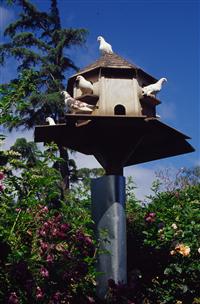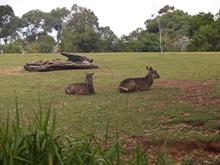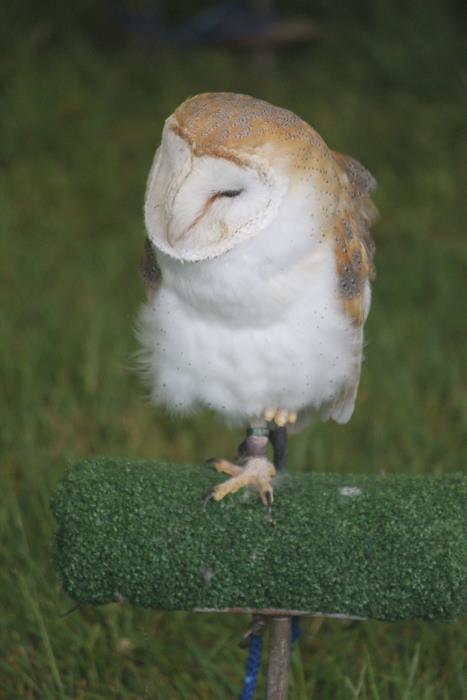
Become a wildlife manager and support critical wildlife populations
Wildlife management is the modification or manipulation of wild populations for the purposes of conservation.
Wildlife managers use various methods to manage populations such as
modifying habitat, controlling pest species, monitoring populations,
reintroducing species and artificially increasing species numbers. This
course will introduce you to many of these techniques and identify where
and when they are most successful.
Career Opportunities with Wildlife
Opportunities
exist with Zoos, Wildlife Parks, Animal Rescue and Relocation, Wildlife
Surveying, Conservation Management, Parks Services, Veterinary
Services.
Graduates may get a start as a volunteer or in an assistant role;
but as their knowledge and skills grow, their career can progress and
new opportunities will always present to those who apply themselves.
Working in wildlife management, education and/or interpretation can be
very rewarding and inspiring.
People who work with wildlife always appear to ‘love’ their job even
though parts of it may be physically demanding and sometimes dirty work.
Being in contact with wildlife and educating others on the conservation
importance of these animals is for some people a dream job.
COURSE STRUCTURE

There are 9 lessons in this course:
- Introduction to Wildlife Management
- Wildlife Ecology
- Wildlife Habitats
- Population Dynamics
- Carrying Capacity
- Wildlife Censuses
- Wildlife Management Techniques
- Wildlife Management Law and Administration
- Wildlife Management Case Study Research Project
Each
lesson culminates in an assignment which is submitted to the school,
marked by the school's tutors and returned to you with any relevant
suggestions, comments, and if necessary, extra reading.
Course Aims
- On successful completion of the course you should be able to do the following:
- Develop a concept of how man manages wildlife populations in different situations around the world.
- Understand and discuss the principles of wildlife ecology.
- Understand wildlife habitats and their importance to managing wildlife.
- Explain how populations of any one species change and adapt to variations in their environment.
- Understand carrying capacity and its importance in managing wildlife populations.
- Explain a range of different methods used to determine the number of individuals in a wildlife population.
- Discuss a range of different wildlife management techniques.
- To understand the potentials and limitations of legal and administrative initiatives, in the pursuance of more effective wildlife management.
- Examine a specific wildlife management case of interest to the student.
Course Duration : 100 self paced hours
The techniques and types of wildlife management vary depending on your location, and as with any job, you will find that you will need to carry out research into the local methods and types of wildlife management. This course is designed to give students a thorough introduction to the principles and practices of wildlife management common to many species around the globe.
This is an experiential learning-based course. Throughout your studies you will have the opportunity to network with and learn from a variety of industry professionals. Establishing real-world relationships and confidence is key to career success.

UK Case Study -The Barn Owl (Tyto alba) and its habitat requirements in the United Kingdom
The current Barn Owl population in the UK is thought to be around 4000 pairs. The population has been significantly reduced since the late 1800s with the mechanisation of farm machinery and increase in human population size leading to more intensive land development. These factors, along with the use of pesticides such as DDTs and rodenticides have led to the significant reduction in population numbers.
The preferred prey species of the Barn Owl is the field vole (Microtus agrestis), but they also prey on shrews and field mice. The presence and quantity of these species will determine the quality of habitat for Barn Owls which is generally open habitat with a good litter layer such as rough grassland, hedgerows, woodland fringes, drainage ditches and agricultural land.
The hunting area of a pair of Barn Owls is usually around ½ mile during the breeding season and 2 miles in winter (due to the reduced amount of prey available). This will translate to an area of around 14-21 hectares in arable farming land and up to 31-47 hectares in pastoral areas.
Owl pairs will generally require 1 breeding site and 1-2 permanent roosting sites, along with other opportunistic roosting sites. They can use man-made structures such as barns, sheds and churches for nesting and roosting. Barn Owls are sedentary by nature, so once they have established a home range they are unlikely to leave it.
The need for breeding and roosting sites and hunting grounds which are rich in prey are a limiting factor to the survival of the Barn Owls. If Barn Owls have access to good habitat they are more likely to survive the less hospitable winter, lay more eggs in the spring and the survival chances of young will increase. Sadly, the reverse will occur in poor habitat.
Mosquitoes
Mosquitoes are a threat to both human and animal populations through the transmission of viral diseases carried by Mosquito populations. One of the most significant of these diseases is Malaria, which is a leading cause worldwide of premature mortality and causes 5.3 million deaths annually. Mosquitoes are responsible for transmitting a range of other diseases including elephantiasis, yellow fever, dengue fever, epidemic polyarthritis, Rift Valley fever, Ross River fever, St Louis encephalitis, West Nile Virus, Japanese encephalitis, LaCross encephalitis Eastern equine encephalitis (EEE) and Western equine encephalitis (WEE). EEE and WEE are found in the US, and causes disease not only in humans but in horses and some bird species. In the US, mosquitoes have also been found responsible for transmitting the West Nile Virus to over 140 different bird species.
Mosquito control is implemented across the world largely to protect humans from disease but is also utilised by wildlife managers in order to protect wildlife. A balance often needs to be sought in the reduction of mosquito populations, as the protection of humans and animals from mosquito transmitted disease is often gained through the use of chemical control, which can result in negative impacts upon human and animal populations.
Mosquito control can be used on a large scale, such as organised programs to reduce populations over a large area and on a small scale through individual actions to control themselves from mosquitos on their own property. Organised mosquito management programs today draw on the principles of integrated pest management, including the following measures:
• Source reduction - removal of mosquito breeding habitats
• Habitat modification – manipulating habitats to reduce breeding
• Biocontrol – introducing natural predators of mosquitoes
• Larvicide – using pesticides to reduce larval populations
• Adulticide – using pesticides to reduce adult populations
Some solutions for malaria control efforts in the third world are: mosquito nets, mosquito nets treated with insecticide (often permethrin), and DDT.
The use of DDT as a mosquito control method has been the subject of a great deal of controversy. It is argued that DDT is the most effective weapon in combating mosquitoes and their diseases, yet the effects of DDT upon biodiversity are significant.
CASE STUDY - The Calgary Zoo’s Swift Fox Survey
The swift fox (Vulpes velox) is a rare, house cat-sized carnivore. Although swift foxes were once so abundant in Canada that 117,025 were trapped between 1853 and 1877, this species was wiped out of Canada and northern Montana by the late 1930s. Since 1983, reintroduction efforts have been underway to restore the carnivore to sustainable levels.
Censuses undertaken between 1997 and 2001 had shown that the abundance and distribution of the Canadian swift fox population had increased substantially and that Canadian reintroductions had helped re-establish swift foxes in many regions of Montana. The previously fragmented population appeared to be connected and the population had changed towards a female-biased sex ratio, thereby increasing effective population size.
Census Objective
The objective of the 2005 census is to determine if changes in population abundance, distribution, or composition of the swift fox had changed since the last census in 2001.
Sampling Plan and Techniques
The study area was originally chosen in 1996 based on habitat criteria and background information. In 2005, the area chosen to sample was based on areas where the swift fox had been found in previous censuses, as well as bordering areas in order to track demographic changes and population expansion. This covered 237 townships across south eastern Alberta, south western Saskatchewan and north central Montana.
A catch and release trapping technique was utilised, with individual live-traps being placed at one kilometre intervals along a five kilometre continuous section of the trail closest to the centre of respective townships. The inter-trap distance was adjusted by up to 100 meters to allow trap placement along fences or on top of hills. Each township was surveyed with six traps for three nights, for a total of 18 trap nights per township. Catch-and-release trapping was conducted on consecutive nights when possible, but this was dependent on weather conditions.
Results
In total, 196 foxes were caught and released: 84 in the Canadian Border Region, which spanned from Many berries, Alberta to Frontier, Saskatchewan; 20 in the Canadian Grasslands Region, which spanned from Frontier, Saskatchewan to the eastern periphery of Grasslands National Park, Saskatchewan; and 92 in the Montana Region, which was contiguous with the Canadian survey area.
The sex ratio of foxes was balanced and foxes had higher body weights than those captured in 2000/2001. For the first time, zero released foxes from the original reintroductions were caught and 100% of captured foxes were wild-born. Of 146 replicated townships spanning an area of 21,954 km2, the proportion of townships with fox captures increased from 39.7% in 2000/2001 to 52.1% during this census.
This increase was primarily driven by an expansion of foxes in Montana, where foxes were found on over half of the townships that did not have captures previously. There was a statistically significant increase in fox abundance, as the number of foxes caught on replicated townships increased by 30.5% from 139 in 2000/2001 to 181 during this census. When townships that had not been surveyed previously were included, the total number of townships with swift fox captures increased by 38.7% from 62 in 2000/2001 to 86 during this census.
Population connectivity improved as all townships with fox captures were separated by no more than one township, whereas 2000/2001 captures were separated by up to three townships. Canadian fox numbers and densities were similar to the high levels documented in 2001 with a 8 2006 population abundance estimate of 647 foxes that indicates population stability, while Montana numbers increased significantly to an estimated 515 foxes, for a combined 2006 population estimate of 1162 foxes.
Why Study with ACS?
Design your own learning pathway.
Study at your own pace, from anywhere, at any time.
Receive prompt, expert support from our team of committed and friendly tutors.
Your learning is our priority. We are flexible and adaptable to meet your educational needs!
Want advice on creating a learning pathway that suits your needs? Speak to one of our friendly staff for today!
Phone - International: +61 7 5562 1088 In Australia: 07 5562 1088
Email - admin@acs.edu.au or studentservices@acs.edu.au